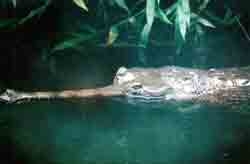Aktiogavialis puertoricensis: fossilized history
Submitted by Daniel Alfonso Colón-Ramos on
Gavialis gangeticus, from the Indian subcontinent, is the only living gharial species related to the Puerto Rican gharial
28 million years ago "pepinianos", as the residents from he Puerto Rican town of San Sebastián are known, could frolic in the shores of their hometown. This is because 28 million years ago the now landlocked town of San Sebastián was a seashore town. Pepinianos looked very different then, though. There were no plazas, or traffic jams, or town fairs... as a matter of fact, 28 million years ago there were no humans, not in Puerto Rico, not anywhere else.
What San Sebasti·n did have were gharial: very large crocodiles basking in its shores.
Today we know of the existence of these prehistoric reptiles in Puerto Rico thanks to the paleontological research of CienciaPR member Jorge Vélez Juarbe and his colleagues Christopher Brochu (University of Iowa) and Hernán Santos (Recinto Universitario de Mayagüez). This group discovered a new and unique gharial species in Puerto Rico. Gharials are crocodiles with a characteristic elongated and narrow snout. Although this group was once common throughout the World, they slowly disappeared and are now only present in the Indian subcontinent.
The Puerto Rican gharial is an extraordinary discovery with repercussions in the fields of paleontology and herpetology. This gharial, named Aktiogavialis puertoricensis, is so different and unique that represents a totally new genus and species. Part of these studies were published by Vélez Juarbe and colleagues in the scientific journal Geobios and Proceedings of the Royal Society B.
Paleontological studies, in combination with multidisciplinary studies in geology, herpetology and evolutionary biology have allowed scientists to better understand the geological and paleobiological context in which the Puerto Rican archipelago existed. These studies have also contributed to our understanding of speciation in Puerto Rico, the American continents and the World.
If you want to learn more about the Puerto Rican gharial or about paleontological research in Puerto Rico please visit the profile of Jorge Vélez Juarbe.








